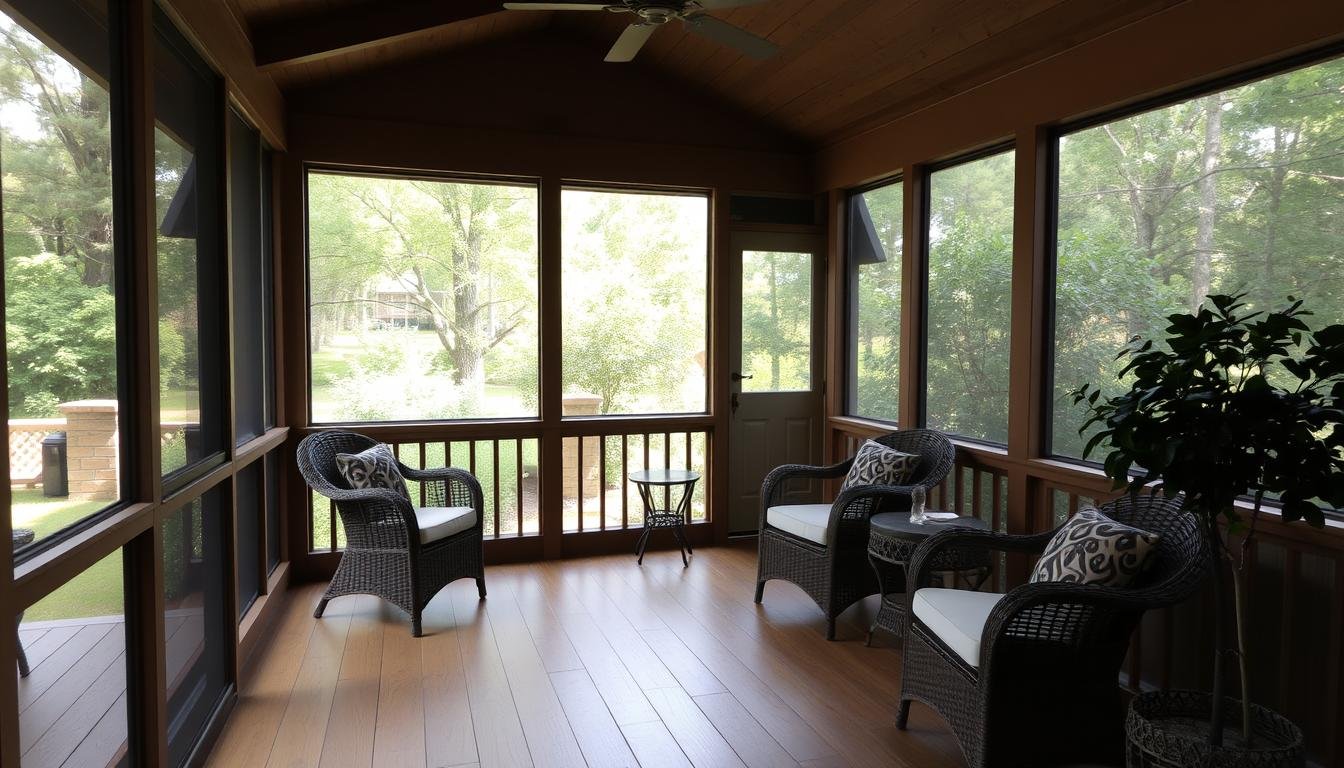Many homeowners wonder if adding a screened porch increases the square footage of their home. The answer is usually no; they don’t count towards your home’s total area. This is mainly because they often lack features like insulation and air systems found inside the house.
However, this doesn’t mean they add no value. Screened porches can greatly improve a house’s appeal. They offer a cozy place to relax and entertain, increasing your home’s worth.
Key Takeaways
- Screened porches are generally not included in your home’s total square footage.
- For a space to be counted, it must have flooring, wall covering, ceiling, and a heating system.
- Screened porches add value by enhancing outdoor living space and entertainment options.
- The return on investment (ROI) for a screened porch is approximately 84%.
- Adding a screened porch can significantly increase homebuyer interest.
- Neighborhood standards and comparable amenities can influence the value a screened porch adds.
Understanding Square Footage Measurement
When you look at home listings or think about a home’s value, knowing about square footage is key. The American National Standards Institute (ANSI) has rules for this. They say to measure the outside of a home, including the thickness of its walls.
The rules for what counts in a home’s square footage focus on the space being finished. This means it should have heat, cooling, and good insulation like the rest of the house. Rooms like bedrooms and kitchens usually meet these rules. But unfinished basements or garages don’t count.
A finished basement room might be worth $90 per square foot. But a room on the main floor might be worth $130 per square foot. Finished attics need to have ceilings at least seven feet high to count. In North Carolina, if half the attic meets this height, it counts in the total square footage.
What local laws say also matters a lot for square footage numbers. Things like balconies that are outside don’t count. In Los Angeles, things like balconies and garages need to be fully done to count. In Seattle, special zoning laws might affect how you measure certain rooms or lofts. People selling homes need to know these details to list homes right and set fair prices.
Here’s a comparison of how much value square footage adds in different states:
| State | Average $/sq. ft. | 10×10 room value | 200 sq. ft. room addition potential value |
|---|---|---|---|
| California | $190 | $19,000 | $20,000-$40,000 |
| Wisconsin | $110 | $11,000 | $20,000-$40,000 |
Properly measuring and reporting square footage is very important in real estate. It helps avoid legal issues, keeps buyers interested, and influences the home’s valuation. For example, a house measured at 862 sq. ft. spread across different rooms impacts its price and sale.
Screened Porches: A Closer Look
*Screened porches* are great for outdoor living without pests or bad weather. They don’t add to your home’s square footage. Yet, they give you extra space to relax or entertain. Many homeowners find them very useful, especially where the weather is mild.
Screening an existing porch can cost between $2,000 and $4,000, about $2,800 on average. Building a new one varies from $25 to $120 per square foot. This means the price can go from $2,000 to $7,500. A brand-new screened porch can cost up to $22,000. Don’t forget money for permits and electrical work.
The materials you pick really affect the price. Screens can be made of aluminum or solar material. Posts might be fiberglass or even stone. The floor could be simple pavers or have fancy heating. Prices range from $2 to $20 per square foot.
| Square Footage | Cost to Enclose | Cost to Build New |
|---|---|---|
| 144 sq. ft. | $2,000 | $7,200 |
| 224 sq. ft. | $2,900 | $11,200 |
| 400 sq. ft. | $5,000 | $20,000 |
Homeowners can see up to an 84% return on investment (ROI) from screened porches. They’re especially popular in hot, humid places. A screened porch can make your home more attractive and marketable.
Choosing a *screened porch* over a pricey sunroom saves money. Sunrooms can cost between $20,000 and $60,000. Screened porches are not only cheaper but also offer nearly year-round use. They’re great for adding functionality or boosting your home’s value.
Local Building Codes and Regulations
It’s key to know local building rules when you’re adding a screened porch. These rules help prevent construction errors and make sure your porch follows the city’s standards. This affects how much your home is worth.
Before you start building, you need to get the right permits. You have to have them for many projects, like building decks and screened porches, adding new rooms, or major changes to your space. Home improvement permits are a must-have.
In New York City, building codes say you must have permits for any big structural changes. This includes taking down walls, changing exits, and turning unused spaces into rooms. These permits make sure your updates are safe and strong.
Here’s a quick guide on what projects need permits:
| Project Type | Permit Requirement |
|---|---|
| New Residential Building | Required |
| Accessory Structures (e.g., Garages, Decks) | Required for structures 100 sq ft or more |
| Maintaining Repairs | Not Required |
| Converting Garages/Porches | Required |
| Demolition or Structure Removal | Required |
| Waterfront Construction | Required |
Talking to local building officials regularly is wise. They give up-to-date permit info. This is crucial to dodge delays and ensure your screened porch meets all rules and safety standards.
Do Screened Porches Count?
In the world of buying and selling homes, people often wonder if a screened porch adds to a home’s square footage. The answer is no because the space isn’t insulated or climate-controlled. Screened porches, due to their lack of heating and cooling, don’t count towards a home’s total square footage.
Even so, screened porches can boost a home’s charm and worth. They can make a house more appealing to buyers and raise its value, with an ROI of about 75% according to homeadvisor.com. They’re especially great in places where you can live outdoors all year round.
When selling a house, the value of a screened porch can help. In areas with lots of bugs, such as the Southeast, screened porches offer a bug-free outdoor area. They also give more privacy than open decks, which is important for many people.
Screened porches have practical perks too. They provide a safe place for kids to play away from open yard dangers. Plus, they let homeowners enjoy the outside in comfort and privacy.
Though they’re not included in the official square footage, screened porches are still valued. They enhance a home by offering attractive and flexible outdoor spaces. This can draw in buyers and influence home prices positively.
So, screened porches might not add to a home’s measured size, but they definitely can make it more desirable and valuable.
Real Estate and Market Value Impact
Having a well-kept screened porch can really boost your home market value. It might not add to the total square footage. But, the perks of a screened porch are clear when looking at your home’s overall charm. Outdoor living enhancements are in big demand in the real estate world.
In places like Texas, home values are figured out in a few ways, like the Cost Method and Market Data Comparison. For example, the materials for your porch are considered. A porch that looks like it’s always been part of the house can up the property resale value. It could give you a return as good as adding a deck, which is about 80%.
The vibe of your neighborhood matters too. In areas where many houses have screened porches, not having one might lower your home’s value. On the flip side, a top-notch porch can make your house more appealing. It can help sell your house faster and make it more desirable to those looking to buy.
Appraisers look at the construction quality and how the porch fits with your house. If the porch isn’t up to par, like lacking proper heating or cooling, it could hurt your home’s appraisal. So, make sure your porch is well-built. This will help boost your home’s appeal and property resale value.
Best Practices for Homeowners
Consider using high-quality materials and solid construction for a screened porch. This approach leads to durability and easy upkeep. Select durable options like pressure-treated lumber and tough screens to make your porch last longer.
Make sure your porch design suits your lifestyle and neighborhood rules. It should serve your need, whether for family time or a quiet spot. Add features like ceiling fans or heaters to enjoy it year-round.
Keeping your porch in good shape is key to its value and your enjoyment. Clean the screens, check for any damage, and seal the wood to protect it. It’s also smart to keep up with local building codes. This ensures legality and enhances your home’s charm. With these tips, homeowners can boost their property’s value and the quality of their living space.




